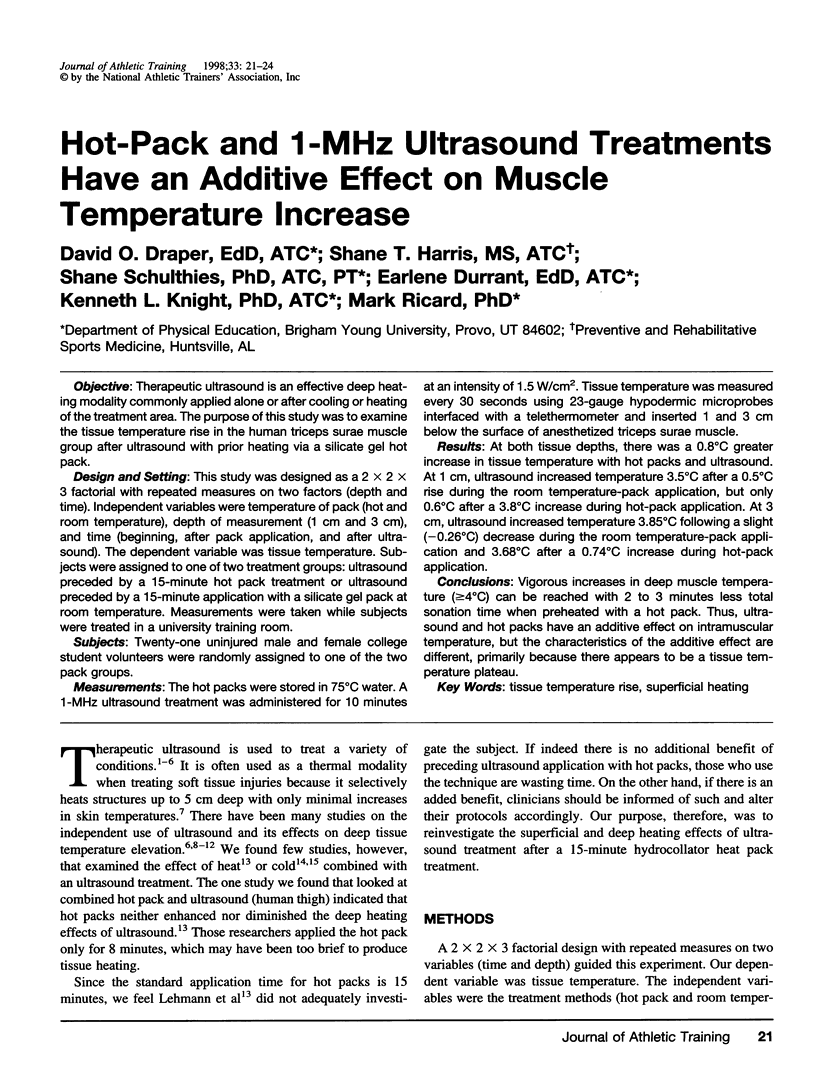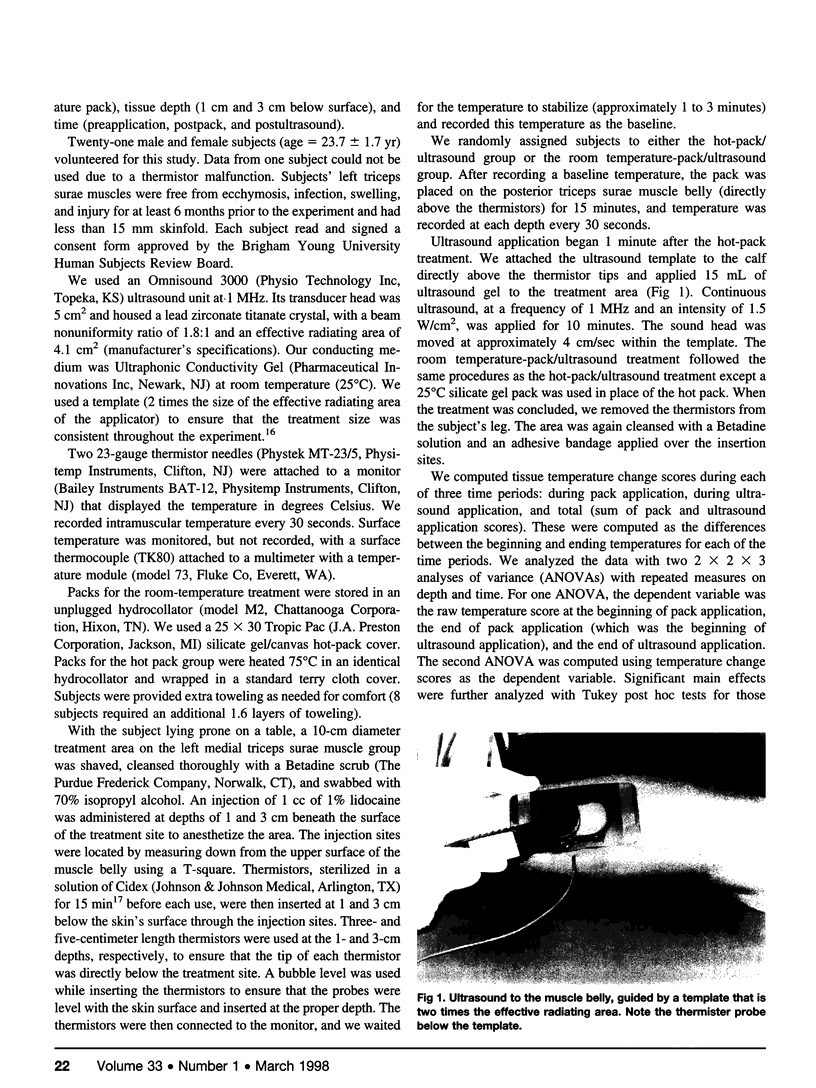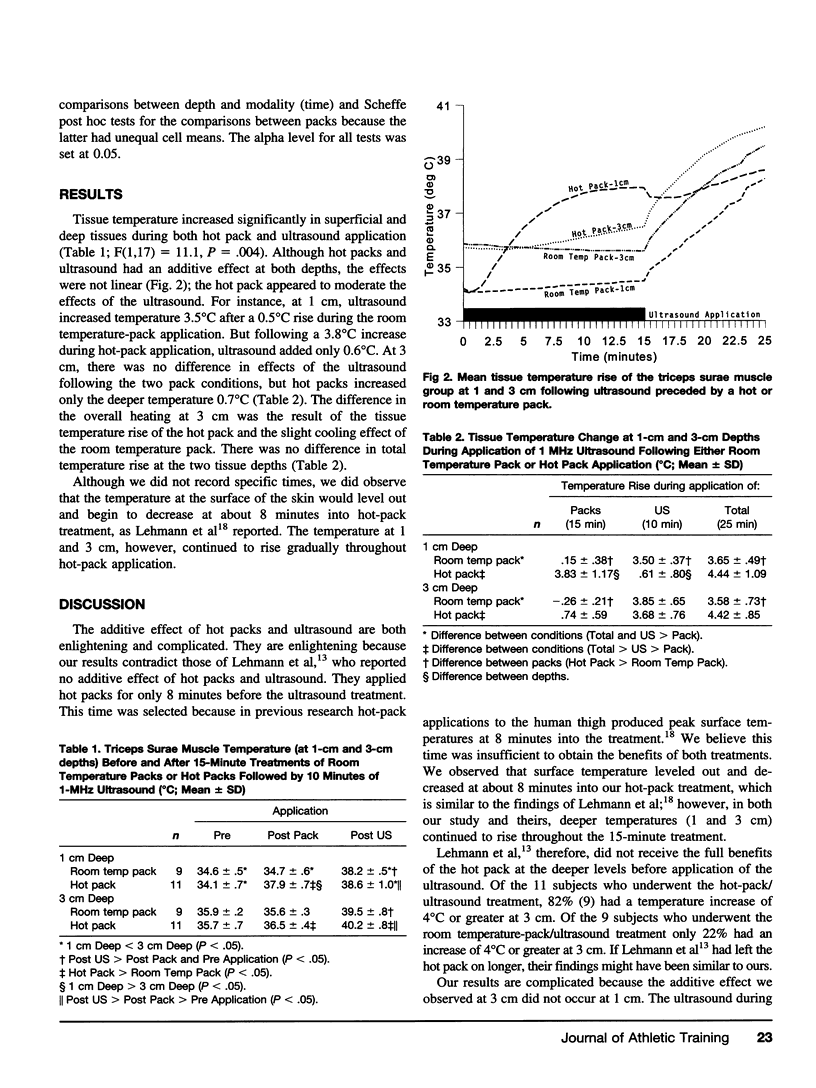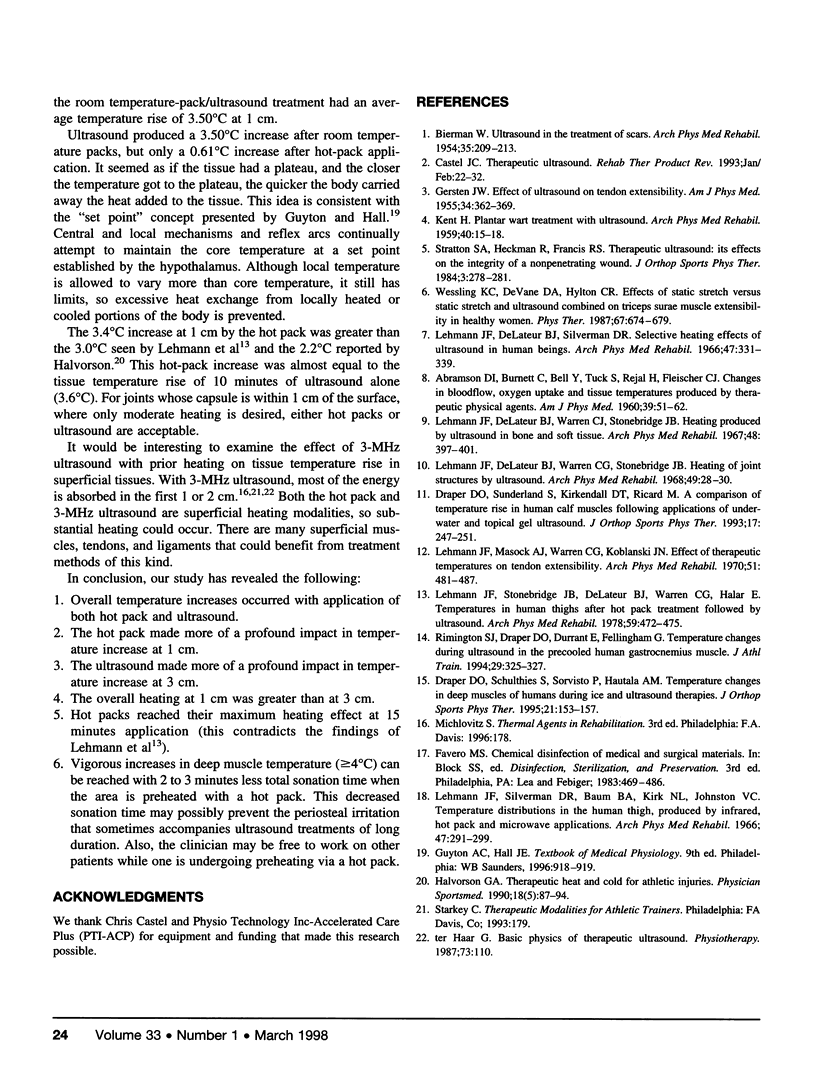Abstract
Objective:
Therapeutic ultrasound is an effective deep heating modality commonly applied alone or after cooling or heating of the treatment area. The purpose of this study was to examine the tissue temperature rise in the human triceps surae muscle group after ultrasound with prior heating via a silicate gel hot pack.
Design and Setting:
This study was designed as a 2 × 2 × 3 factorial with repeated measures on two factors (depth and time). Independent variables were temperature of pack (hot and room temperature), depth of measurement (1 cm and 3 cm), and time (beginning, after pack application, and after ultrasound). The dependent variable was tissue temperature. Subjects were assigned to one of two treatment groups: ultrasound preceded by a 15-minute hot pack treatment or ultrasound preceded by a 15-minute application with a silicate gel pack at room temperature. Measurements were taken while subjects were treated in a university training room.
Subjects:
Twenty-one uninjured male and female college student volunteers were randomly assigned to one of the two pack groups.
Measurements:
The hot packs were stored in 75°C water. A 1-MHz ultrasound treatment was administered for 10 minutes at an intensity of 1.5 W/cm². Tissue temperature was measured every 30 seconds using 23-gauge hypodermic microprobes interfaced with a telethermometer and inserted 1 and 3 cm below the surface of anesthetized triceps surae muscle.
Results:
At both tissue depths, there was a 0.8°C greater increase in tissue temperature with hot packs and ultrasound. At 1 cm, ultrasound increased temperature 3.5°C after a 0.5°C rise during the room temperature-pack application, but only 0.6°C after a 3.8°C increase during hot-pack application. At 3 cm, ultrasound increased temperature 3.85°C following a slight (-0.26°C) decrease during the room temperature-pack application and 3.68°C after a 0.74°C increase during hot-pack application.
Conclusions:
Vigorous increases in deep muscle temperature (≥4°C) can be reached with 2 to 3 minutes less total sonation time when preheated with a hot pack. Thus, ultrasound and hot packs have an additive effect on intramuscular temperature, but the characteristics of the additive effect are different, primarily because there appears to be a tissue temperature plateau.
Keywords: tissue temperature rise, superficial heating
Full text
PDF



Images in this article
Selected References
These references are in PubMed. This may not be the complete list of references from this article.
- ABRAMSON D. I., BURNETT C., BELL Y., TUCK S., Jr, REJAL H., FLEISCHER C. J. Changes in blood flow, oxygen uptake and tissue temperatures produced by therapeutic physical agents. Am J Phys Med. 1960 Apr;39:51–62. [PubMed] [Google Scholar]
- BIERMAN W. Ultrasound in the treatment of scars. Arch Phys Med Rehabil. 1954 Apr;35(4):209–214. [PubMed] [Google Scholar]
- Draper D. O., Schulthies S., Sorvisto P., Hautala A. M. Temperature changes in deep muscles of humans during ice and ultrasound therapies: an in vivo study. J Orthop Sports Phys Ther. 1995 Mar;21(3):153–157. doi: 10.2519/jospt.1995.21.3.153. [DOI] [PubMed] [Google Scholar]
- Draper D. O., Sunderland S., Kirkendall D. T., Ricard M. A comparison of temperature rise in human calf muscles following applications of underwater and topical gel ultrasound. J Orthop Sports Phys Ther. 1993 May;17(5):247–251. doi: 10.2519/jospt.1993.17.5.247. [DOI] [PubMed] [Google Scholar]
- GERSTEN J. W. Effect of ultrasound on tendon extensibility. Am J Phys Med. 1955 Apr;34(2):362–369. [PubMed] [Google Scholar]
- KENT H. Plantar wart treatment with ultrasound. Arch Phys Med Rehabil. 1959 Jan;40(1):15–18. [PubMed] [Google Scholar]
- Lehmann J. F., DeLateur B. J., Silverman D. R. Selective heating effects of ultrasound in human beings. Arch Phys Med Rehabil. 1966 Jun;47(6):331–339. [PubMed] [Google Scholar]
- Lehmann J. F., DeLateur B. J., Warren C. G., Stonebridge J. B. Heating of joint structures by ultrasound. Arch Phys Med Rehabil. 1968 Jan;49(1):28–30. [PubMed] [Google Scholar]
- Lehmann J. F., DeLateur B. J., Warren C. G., Stonebridge J. S. Heating produced by ultrasound in bone and soft tissue. Arch Phys Med Rehabil. 1967 Aug;48(8):397–401. [PubMed] [Google Scholar]
- Lehmann J. F., Masock A. J., Warren C. G., Koblanski J. N. Effect of therapeutic temperatures on tendon extensibility. Arch Phys Med Rehabil. 1970 Aug;51(8):481–487. [PubMed] [Google Scholar]
- Lehmann J. F., Silverman D. R., Baum B. A., Kirk N. L., Johnston V. C. Temperature distributions in the human thigh, produced by infrared, hot pack and microwave applications. Arch Phys Med Rehabil. 1966 May;47(5):291–299. [PubMed] [Google Scholar]
- Lehmann J. F., Stonebridge J. B., deLateur B. J., Warren C. G., Halar E. Temperatures in human thighs after hot pack treatment followed by ultrasound. Arch Phys Med Rehabil. 1978 Oct;59(10):472–475. [PubMed] [Google Scholar]
- Rimington S. J., Draper D. O., Durrant E., Fellingham G. Temperature changes during therapeutic ultrasound in the precooled human gastrocnemius muscle. J Athl Train. 1994 Dec;29(4):325–327. [PMC free article] [PubMed] [Google Scholar]
- Stiles W. B. When more of a good thing is better: reply to Hayes et al. (1996) J Consult Clin Psychol. 1996 Oct;64(5):915–918. doi: 10.1037//0022-006x.64.5.915. [DOI] [PubMed] [Google Scholar]
- Wessling K. C., DeVane D. A., Hylton C. R. Effects of static stretch versus static stretch and ultrasound combined on triceps surae muscle extensibility in healthy women. Phys Ther. 1987 May;67(5):674–679. doi: 10.1093/ptj/67.5.674. [DOI] [PubMed] [Google Scholar]



